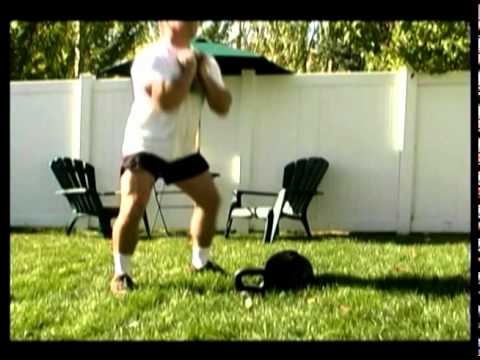Dan John has always been one of my favorite strength and conditioning gurus to follow. Then again, I may be a tad bit biased considering we share the same love for throwing odd implements for a distance. Nonetheless, he’s a man who knows his stuff, and his ability to dumb-down difficult concepts nearly never fails. Indeed, he is also a very humorous fellow in the case that you were formerly unaware. Need proof? I offer you to take a look at the first minute and half of the video above. I’m sure you will catch my drift. After the first minute and a half of the video, Dan ends up showing us how to do a kettlebell goblet squat.
The goblet squat is a movement that can be done with literally just about any implement. Find a heavy stone, maybe a kettlebell or a dumbbell, or anything for that matter that will provide you some solid resistance. All you need to do is pick it up, hold it at your chest, and then squat with it.
I guess since we’re at it, we should probably tackle some issues with the squat.
Now, there are different modes of thought when it comes to doing a proper squat. Some people teach us to go to 90 degrees or parallel, while others teach us to do a full or below parallel squat. Other people teach to keep the feet pointed out, while others teach the feet to be pointed straight forward.
Instead of nitpicking at who is right and who is wrong between the two frames of mind, let’s just say that they are both right, and tackle the areas that are really going to make or break the squat movement. My purpose right now is not to say one way is more right or wrong than the other, but to instead, expand on the areas that I feel are most important for both prevention of injury and optimally progressing strength in the squat movement.
Most Important Concepts:
- We DO NOT want to break at the waist on the way down. A pretty obvious rule of thumb indeed; however, the more blatantly obvious a concept is, the more we tend to lack focus and allow it to get lost in all else that goes on in our lives. We should be keeping our spine in a neutral and supported position. A proper squat is all about glute activation and if we are not activating with the glutes it means that we are compensating with other areas of the body, which can, and most likely will, put us at a serious risk of injury.
- As Dan John alluded to in the video, we DO NOT want to shift our weight onto our toes. Instead, we should keep our weight back onto our heels. This will help activate the entire posterior chain including the glutes. The activation of the posterior chain will not only allow us to create more opportunity for power expenditure—meaning we will be able to move a greater amount of weight—it will also prevent certain muscular imbalances and further postural issues.
Conclusion
To sum it all up, there are many different pathways to the same destination of the squat, either way the core foundations of the squat holds true across all paths. My advice is to always do what is most comfortable for you, but at the same time, make sure that the movement is functional and will maintain, or help progress toward, proper postural alignment. The important takeaway points with the kettlebell goblet squat, or any kind of squat for that matter, is to make sure that the posterior chain and the glutes are being activated. Remember: Maintaining a neutral and supported spine, as well as keeping the weight back on the heels, will both help in making sure that the posterior chain and the glutes are being properly activated.
Greg Pearson is an exercise science major at Shippensburg University of Pennsylvania with minors in biology and coaching. He is also a lifelong athlete – involved in the sports of basketball, baseball, football, track & field and volleyball growing up. Competed at Shippensburg University in the shot put, discus, and hammer events as a Division II Track & Field athlete. You can contact Greg via e-mail: [email protected] or his linkedin profile.


Comments
Hey Logan whats your take on Smith machines as far as doing squats? Some people say it is a waste of time and better to do the barbell (free weight).
I really don’t like the smith machine personally. Being trapped in one plane of motion, just doesn’t feel as good as having the freedom to move in any direction. Since any sport or actual weightlifting will require more of the stabilization it just won’t carryover the same way. That’s not to say its useless, but if you have an option I would avoid using that machine.
Ok, thanks for your take on it!